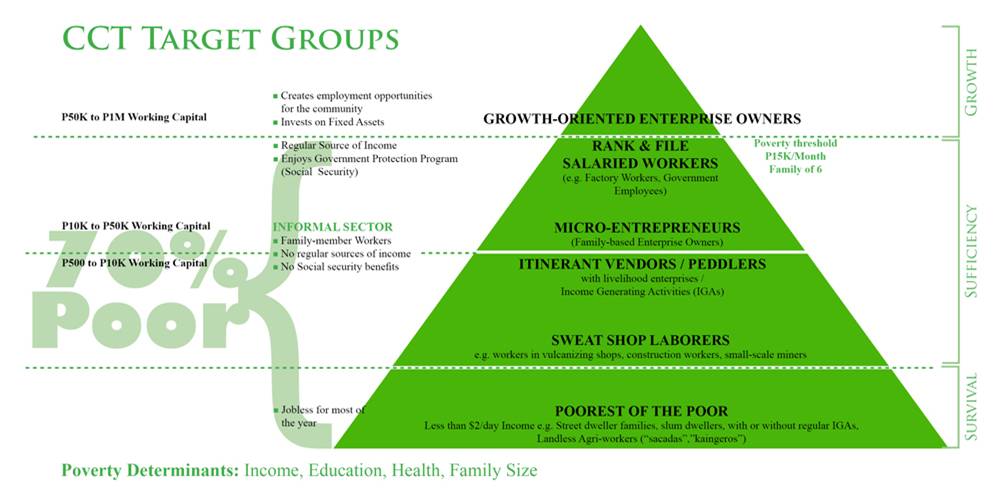
The past couple weeks at CCT in Manila provided me with an opportunity to take a closer look at the multitude of poverty alleviation services the organization provides. CCT targets several poverty groups (see diagram below), and tailors programs to each accordingly. Micro-entrepreneurs, broadly categorized in the middle of the poverty pyramid, are the recipients of the small business loans posted on Kiva. “Sufficiency” is the primary objective for this program, a mission reflected in the reality of loan utilization I observed in interviews with borrowers (primarily working capital financing). Above micro-entrepreneurs on the targeted groups pyramid is growth oriented business (those receiving loans in excess of 50,000 pesos (~$1,000) and hopefully hiring employees) and below, sweat shop laborers and “the poorest of the poor,” for which the primary objective is mere survival.
As part of an ambitious effort aimed at the latter group, CCT has developed the “Kaibigan Village” (Kaibigan meaning friend in Tagalog), a small, self-sustaining village three hours outside Manila, that I was lucky enough to visit. The village is inhabited by six families, all of whom used to be “street dwellers,” that work on both communal projects, such as pig and goat raising, as well as individual projects, including growing vegetables and raising chickens. A couple of CCT staff live in the village to help coordinate fellowship meetings, provide security etc., however, the village is largely run by its citizens. Emotional testimonials provided by two Kaibigans who spoke to the group as I sat down for its first ever “corporate worship,” made the transformative value of the program clear. Whether this is a program that can be viably scaled up to reach more groups is unknown, though the continuous generosity of donors suggests there is hope: another village is under construction a few miles down the road.
I also ventured to the “Kaibigan Community Center” in Pasay City, about twenty minutes south of central Manila, to attend the official opening of a new clean water station developed with sponsorship from several companies and development organizations. The purification system uses a filtering system and UV rays to kill bacteria in the water. I had a newly bottled liter of the purified water and it was, though perhaps an odd choice of words given the quintessentially tasteless subject, delicious, particularly in the heat of the one o-clock sun. The ceremony ended with a basketball game featuring players from the areas around two of CCTs water stations. Responsible microfinance organizations know that microfinance is not a development panacea, but it is refreshing to observe one that acts on this insight.
Leadership gurus often warn about creating excessively lofty goals for organizations, arguing that any disconnect between pragmatism and stated objectives will demoralize staff. While CCT’s objectives are certainly lofty, they instead seem to stoke a tenacious creativity exemplified in projects like the Kaibigan Village and water station that supplement the organization’s microfinance work. Here’s to their continued success.
by Nick Whalley, KF12, Philippines















